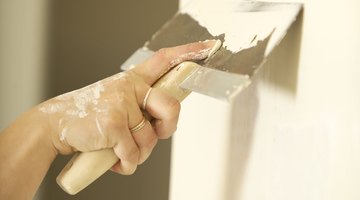How to Repair Drywall Cracking Due to Humidity

High humidity is as hard on your house as it is on you and your family. Extra moisture in the air can make your floors swell, your furniture finishes turn cloudy and your walls crack. The moisture may crack the drywall, but it more commonly causes the water-soluble joint compound covering the taped seams to deteriorate and form hairline fissures. You can easily repair cracks with joint compound, but you should heed a warning. Cracks in the wall can have a more serious cause -- foundation settling. If that's the case, cosmetic repairs may not be enough.
Step 1
Run a 4-inch drywall knife over the crack to scrape off flaking paint and old mud. If any paper tape has separated from the wall, cut it off with a utility knife and scrape around the area to remove loosened mud.
Step 2
Fill cracks wider than 1/4 inch with patching compound, which is a wall repair material that sets to a rock-hard consistency. Mix a little of the patching compound powder with water to form a stiff paste and trowel it into the crack with a putty knife. Scrape off all the excess. Patching compound is difficult to sand once it sets.
Step 3
Apply fresh drywall tape to any areas from which you removed peeling tape. Spread joint compound on the area and lay moistened tape in the fresh compound. Scrape over the tape with the drywall knife to flatten it.
Step 4
Cover the repair with a coat of drywall joint compound and scrape it flat. Let it dry overnight, then apply a second coat. Sand the final coat with 120-grit sandpaper when it dries.
Step 5
Coat the repair with drywall primer. Let it dry, then apply a coat of paint to complete the repair.
Tip
Cracks that spread from doorways or windows are often due to moisture seeping through the exterior sheathing. You may be able to stop this from happening by re-caulking the exterior door or window trim.
Warning
Moisture cracks are usually thin. If you have wide cracks, your framing may be expanding and contracting, which is normal if the house is new. The cause may also be foundation settling, which can create serious problems. If you suspect this, hire a contractor to investigate.
Things You Will Need
- 4-inch drywall knife
- Utility knife
- Patching compound
- Putty knife
- Drywall joint compound
- Paper drywall tape
- 120-grit sandpaper
- Drywall primer
- Wall paint
References
Writer Bio
Chris Deziel has a bachelor's degree in physics and a master's degree in humanities. Besides having an abiding interest in popular science, Deziel has been active in the building and home design trades since 1975. As a landscape builder, he helped establish two gardening companies.
Photo Credits
- Brand X Pictures/Brand X Pictures/Getty Images
- Brand X Pictures/Brand X Pictures/Getty Images
More Articles


